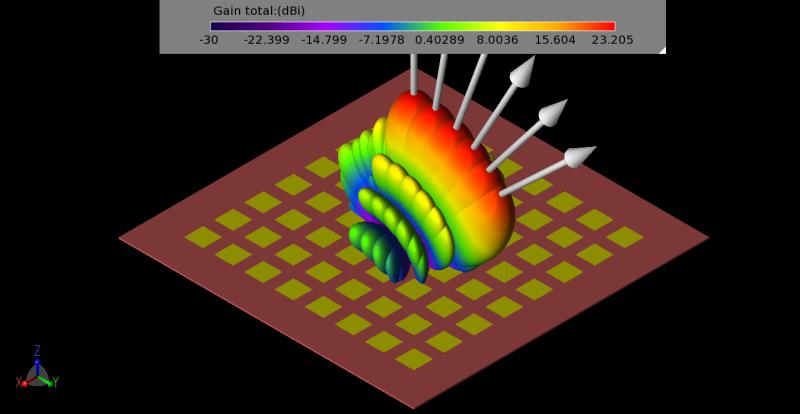What is the two dimensional matrix antenna array?
A two-dimensional matrix antenna array, also known as a planar antenna array, is a configuration of multiple antennas arranged in both rows and columns. This arrangement allows for a high degree of control over the directionality and radiation pattern of the antenna system. Matrix antenna arrays are commonly used in various applications, particularly in the field of radar, wireless communications, and beamforming technologies.
Key Features of Two-Dimensional Matrix Antenna Arrays:
Rows and Columns:
- The antennas in a two-dimensional matrix array are organized in rows and columns, forming a grid-like structure. The intersections of rows and columns represent individual antenna elements.
Element Spacing:
- The spacing between the individual antenna elements, both in the row and column directions, is carefully designed to achieve specific performance characteristics. The spacing is often a fraction of the wavelength of the operating frequency.
Beam Steering:
- By controlling the phase and amplitude of the signals fed to each antenna element, a two-dimensional matrix array can steer the direction of the main beam. This capability is known as electronic beamforming.
Adaptive Beamforming:
- Matrix antenna arrays can adaptively adjust the beam direction in real-time based on changing conditions or requirements. This adaptability is particularly useful in dynamic environments.
High Gain and Directivity:
- The combination of multiple antenna elements and beamforming capabilities results in higher gain and directivity compared to single antennas. This is advantageous for long-range communication and radar applications.
Null Steering:
- In addition to steering the main beam, matrix antenna arrays can also create nulls (directions with minimal radiation) to mitigate interference or unwanted signals.
Applications of Two-Dimensional Matrix Antenna Arrays:
Radar Systems:
- Matrix antenna arrays are widely used in radar systems for target detection, tracking, and imaging. Beamforming allows radar systems to focus energy in specific directions.
Wireless Communications:
- In wireless communication systems, matrix antenna arrays are employed in base stations to enhance the coverage, capacity, and data rates. Beamforming helps in directing signals towards specific users.
Satellite Communications:
- In satellite communication systems, matrix antenna arrays can be used to form high-gain directional beams, improving communication link performance.
5G Networks:
- The deployment of 5G networks benefits from the use of matrix antenna arrays to support massive MIMO (Multiple Input, Multiple Output) technologies, enabling high-capacity and low-latency communication.
Smart Antenna Systems:
- Matrix antenna arrays are essential components in smart antenna systems that dynamically adjust their radiation patterns to optimize signal reception and transmission.
Automotive Radar:
- In automotive applications, such as adaptive cruise control and collision avoidance systems, matrix antenna arrays are employed for accurate detection and tracking of objects around the vehicle.
Aerospace and Defense:
- Matrix antenna arrays find extensive use in aerospace and defense applications for surveillance, communication, and electronic warfare.
The design and optimization of two-dimensional matrix antenna arrays involve considerations of array geometry, element spacing, and the algorithms used for beamforming and signal processing. These arrays play a crucial role in enabling advanced wireless and radar technologies across various industries.
A two-dimensional matrix antenna array is an arrangement of antennas organized in a grid-like pattern, with rows and columns of individual antennas. This configuration allows for enhanced control over the radiation pattern of the array, enabling beamforming and other advanced signal processing techniques.
Here's a more detailed description of the key characteristics of a two-dimensional matrix antenna array:
Grid-like Structure: The antennas are arranged in a regular pattern, forming rows and columns, creating a matrix-like structure.
Beamforming Capabilities: The array can manipulate the direction and amplitude of the transmitted or received signal by adjusting the phase and amplitude of each antenna element. This enables beamforming, directing the signal towards a specific direction or suppressing interference from unwanted directions.
Spatial Diversity: The multiple antennas provide spatial diversity, improving signal-to-noise ratio (SNR) and reducing the impact of multipath propagation effects.
Resolution and Directivity: The array's resolution and directivity are determined by the number of antennas, their spacing, and the operating frequency. A larger array with closer spacing generally provides higher resolution and directivity.
Versatility: Two-dimensional matrix antenna arrays can be used for various applications, including radar, wireless communication, radio astronomy, and medical imaging.
Hardware Complexity: Compared to single-antenna systems, two-dimensional matrix antenna arrays require more complex hardware and signal processing algorithms.
Adaptive Beamforming: Advanced techniques like adaptive beamforming can be employed to dynamically adjust the array's radiation pattern based on real-time signal conditions.
Applications in MIMO Systems: Two-dimensional matrix antenna arrays are essential components in multiple-input, multiple-output (MIMO) systems, enabling spatial multiplexing and increased data rates.
Array Calibration: Maintaining accurate phase and amplitude calibration between antenna elements is crucial for optimal performance.
Computational Complexity: Beamforming and other signal processing techniques can be computationally demanding, especially for large arrays.
In summary, two-dimensional matrix antenna arrays offer enhanced control over the radiation pattern, enabling beamforming and improved signal processing capabilities. They are widely used in various applications, including radar, wireless communication, and medical imaging.













